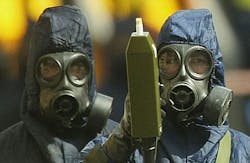Pentagon eyes hand-held detector to protect warfighters from biological warfare attacks
FORT BELVOIR, Va., 19 Jan. 2012.Biological warfare experts at the U.S. Defense Threat Reduction Agency (DTRA) at Fort Belvoir, Va., are asking industry for ideas on developing a handheld devices for front-line warfighters that are able to identify and characterize infectious disease agents and biothreats to protect deployed military forces from biological warfare agents and emerging infectious diseases that are occur naturally occurring result from bio-terrorism attacks.
The DTRA The Joint Program Manager - Transformational Medical Technologies (JPM-TMT) issued a request for information (RFI-12-DTRA01) Wednesday for the Development of Handheld Pathogen Identification and Characterization System program. Officials caution that this is a request for information and not yet a formal solicitation.
This RFI seeks information on existing technologies for analysis to include pathogen characterization and identification, and the potential to identify chemical agents, as well as sample preparation prior to analysis on a handheld device in an integrated, end-to-end system. JPM-TMT officials are interested only in technologies developed to at least to the point of a working prototype.
The JPM-TMT is seeking industry ideas for a lightweight, easy-to-use, handheld bio-identification system to help front-line warfighters identify and characterize pathogens. This handheld bio-identification system should be held easily in one hand by any service member, and be able to identify and characterize a sample for several different pathogens, biological agents, biological toxins, and chemical agents.
Most importantly, military officials want the capability to identify and characterize bio-warfare agents and infectious disease agents. Of secondary concern is the ability to identify biological toxins and chemical agents.
The sample-preparation component must be used together with a handheld bio-identifier, and must be reliable in front-line military operations. The entire process from the start of sample preparation to completion of analysis should take no more than one hour.
Companies interested should respond with five-page papers describing their capabilities no later than 17 Feb. 2012. E-mail responses to Victor Cramer at [email protected].
More information is online at https://www.fbo.gov/spg/ODA/DTRA/DTRA01/RFI-12-DTRA01/listing.html.

